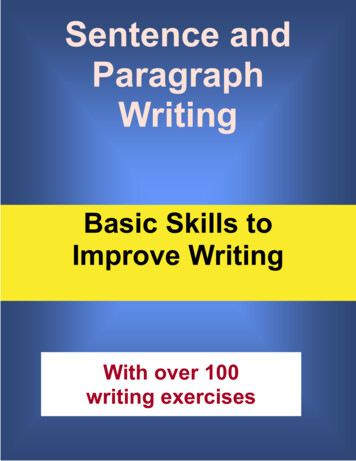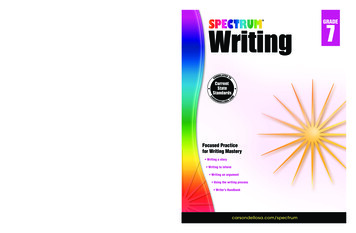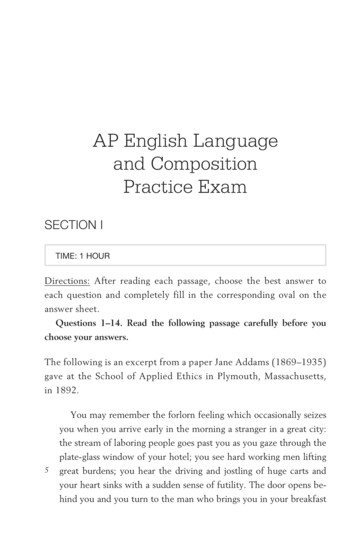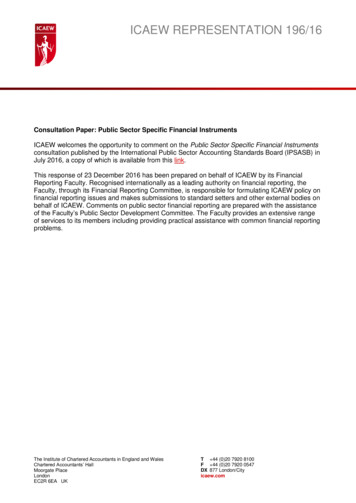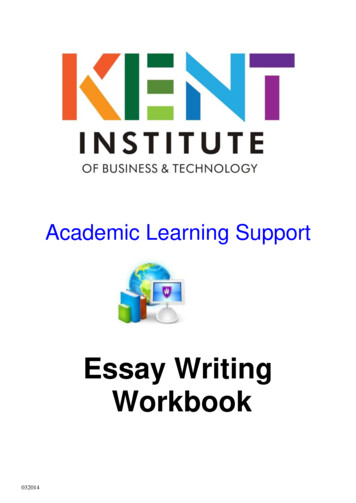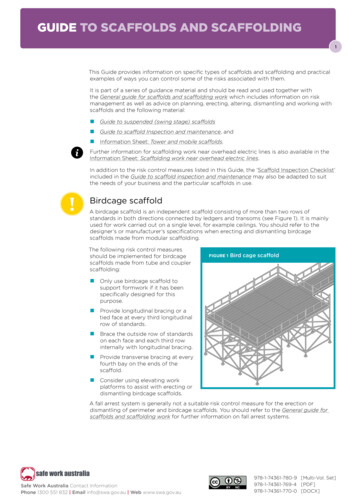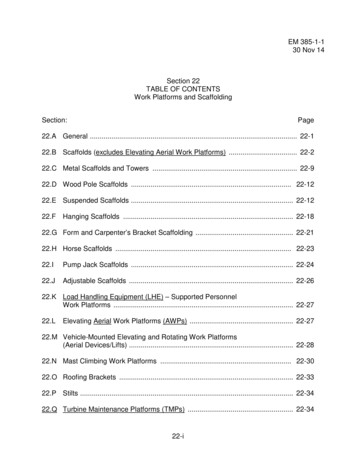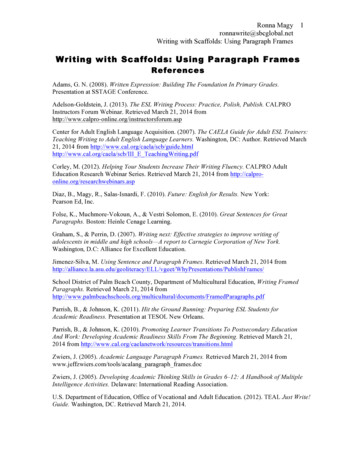
Transcription
Ronna Magyronnawrite@sbcglobal.netWriting with Scaffolds: Using Paragraph Frames1Writing with Scaffolds: Using Paragraph FramesReferencesAdams, G. N. (2008). Written Expression: Building The Foundation In Primary Grades.Presentation at SSTAGE Conference.Adelson-Goldstein, J. (2013). The ESL Writing Process: Practice, Polish, Publish. CALPROInstructors Forum Webinar. Retrieved March 21, 2014 aspCenter for Adult English Language Acquisition. (2007). The CAELA Guide for Adult ESL Trainers:Teaching Writing to Adult English Language Learners. Washington, DC: Author. Retrieved March21, 2014 from cal.org/caela/scb/III E TeachingWriting.pdfCorley, M. (2012). Helping Your Students Increase Their Writing Fluency. CALPRO AdultEducation Research Webinar Series. Retrieved March 21, 2014 from http://calproonline.org/researchwebinars.aspDiaz, B., Magy, R., Salas-Isnardi, F. (2010). Future: English for Results. New York:Pearson Ed, Inc.Folse, K., Muchmore-Vokoun, A., & Vestri Solomon, E. (2010). Great Sentences for GreatParagraphs. Boston: Heinle Cenage Learning.Graham, S., & Perrin, D. (2007). Writing next: Effective strategies to improve writing ofadolescents in middle and high schools—A report to Carnegie Corporation of New York.Washington, D.C: Alliance for Excellent Education.Jimenez-Silva, M. Using Sentence and Paragraph Frames. Retrieved March 21, 2014 et/WhyPresentations/PublishFrames/School District of Palm Beach County, Department of Multicultural Education, Writing FramedParagraphs. Retrieved March 21, 2014 documents/FramedParagraphs.pdfParrish, B., & Johnson, K. (2011). Hit the Ground Running: Preparing ESL Students forAcademic Readiness. Presentation at TESOL New Orleans.Parrish, B., & Johnson, K. (2010). Promoting Learner Transitions To Postsecondary EducationAnd Work: Developing Academic Readiness Skills From The Beginning. Retrieved March 21,2014 from ons.htmlZwiers, J. (2005). Academic Language Paragraph Frames. Retrieved March 21, 2014 fromwww.jeffzwiers.com/tools/acalang paragraph frames.docZwiers, J. (2005). Developing Academic Thinking Skills in Grades 6–12: A Handbook of MultipleIntelligence Activities. Delaware: International Reading Association.U.S. Department of Education, Office of Vocational and Adult Education. (2012). TEAL Just Write!Guide. Washington, DC. Retrieved March 21, 2014.
Ronna Magyronnawrite@sbcglobal.netWriting with Scaffolds: Using Paragraph Frames2Writing with Scaffolds: Using Paragraph FramesJigsaw Reading1. What is a Paragraph Frame?After completing prewriting activities one way for teachers to move ESL students into thenext stage of the writing process is through the use of a paragraph model or paragraphframe. Similar in form to a cloze fill-in exercise, paragraph frames guide students as theyconstruct sentences to form paragraphs.Gail Adams, in writing about the importance of supporting student writing, explains: “Oneof the best research-validated procedures for scaffolding and supporting emerging writersis the use of paragraph frames. “When a paragraph frame is used,” she continues, “a portionof the paragraph is provided and students complete the remainder. First, they (students)learn about the structure of a paragraph including use of a topic sentence and related details.In addition,” she continues, “they (students) gain both sentence and paragraph sense, learnhow to generate ideas for a paragraph, practice writing related sentences using a paragraphstructure and practice rereading and proofreading their composition.” Adams, G. Written Expression: Building the Foundation in Primary GradesMy Favorite Placeis my favorite place. One reason I like it is that.Another reason is thatThere is no place as wonderful as .2. Use a Paragraph Frame to Strengthen Thinking Skills and Academic LanguageAccording to Jeff Zwiers in Developing Academic Thinking Skills in Grades 6–12: AHandbook of Multiple Intelligence Activities, “ it is vital to model the types of writing thatyou want your students to do, and to provide plenty of good samples for them to analyze.”Zwiers explains, a paragraph frame is a writing scaffold which can be used to strengthenstudents’ academic language and thinking skills. (Zwiers, pp. 16-17).Paragraph writing frames can be used to scaffold writing and guide students as they writesentences and paragraphs which: analyze, categorize and classify information, describe,compare and contrast, give supporting arguments, find commonalities, persuade,interpret, show cause and effect, provide problem solving, etc. “Frames,” Zwiersexplains, “ .help students to gradually pick up academic language and eventually use it tocompose their own high-quality written products without help.” (Zwiers, pp. 49, 74).Paragraph frames: Explicitly teach ESL writers the academic language needed to communicate abstractand higher order thinking (Using frames is a great way to scaffold instruction andbuild learners’ confidence in writing, particularly in writing tasks and genres with
Ronna Magyronnawrite@sbcglobal.netWriting with Scaffolds: Using Paragraph Frames3which they have little prior experience.) Allow students to express thoughts and ideas that are more complex than theircurrent English proficiency levelIncrease fluency by providing scaffolding supportServe as a means to reduce student anxiety about using correct EnglishProvide temporary assistance so the student will be able to complete a similarwriting task in the future3. Paragraph Frames Provide a Direct, Guided Writing ModelAccording to the TEAL (Teaching Excellence in Adult Literacy) Center Fact Sheet onResearch-Based Writing Instruction, teaching using a paragraph frame model is a good wayto scaffold instruction and build learners’ confidence in their own writing. Practice withdirect, guided writing models, is very effective. Because many “adult education students,are not familiar with different types of written genres, the explicit study of formats, styles,tones, vocabularies, sentence structures, etc. can provide new frames and words” for studentwork. TEAL Center Fact Sheet on Research-Based Writing Instruction. 2012.“A writing frame consists of a skeleton outline given to learners to scaffold their writing.By providing a few sentence starters and some rhetorical phrases common to the taskor genre, frames give learners a structure that allows them to focus on expressing theirthoughts. They also help learners incorporate vocabulary they have learned in a given topicand create more sophisticated sentences and paragraphs ”Paragraph frames: Provide a structure on which to hang ideas Provide sentence starters Provide support for struggling writers Can be differentiated to stretch more competent writersU.S. Department of Education, Office of Vocational and Adult Education. Just Write!Guide pp. 46-47.4. Using Think-Alouds with Paragraph WritingA “think-aloud” is when a teacher takes time during instruction to describe their thinkingprocess to their class. Think-alouds allow students to see how the thought process of theteacher works. During a writing think-aloud, a teacher would verbalize their thinking aboutthe writing lesson while at the same time using academic language.Right now, I want you to watch and listen to what I do and say. Imagine I am astudent and I am sitting at my desk. It is just me, the desk, and my work. I want youto see what goes on in my mind as I look at my writing. I want to turn my writinginto a good paragraph.I’m going to follow the paragraph writing frame for comparing and look at mypaper and see if I have included all the elements of a good paragraph. Let’ssee .
Ronna Magyronnawrite@sbcglobal.netWriting with Scaffolds: Using Paragraph Frames 4In the introduction, do I have two things that I am comparing? No .so Ineed to fill them in.Do I show how the two things are the same, or similar? One of the details isnot clear, so I need to make it clearer.Do I show how the two things are different, how they differ? Yes.Do I need a conclusion, an ending for my paragraph?.I don’t have aconclusion.So, I need to write a conclusion.Let me go back and write my introduction .the introductory statement.The use of a paragraph frame should begin with a discussion of paragraph writing (andthe elements of a good paragraph) and how using a paragraph frame supports thewriting. This discussion would be followed by teacher and students jointly filling in aframe. Later, students would write on their own while using a frame for support. By makingacademic literacy explicit in this way, writing frames help learners improve their readingcomprehension and begin to predict and follow the academic style of writing.U.S. Department of Education, Office of Vocational and Adult Education. TEAL JustWrite! Guide. Washington, DC. (2012)Procedure for Implementing a Jigsaw ReadingTeacher provides participants a lesson to work on in teams.The lesson is divided into sections.Participants form teams of 4. They number off 1-2-3-4 within teams.Person 1 reads Section A of the reading, Person 2 reads Section B, Person 3reads Section C, and Person 4 reads Section D. Each participant reads/scans their section within the time allotted and eithersummarizes what they read, or reports answers to assigned questions. Team members report back to the team on their assigned tasks. Other team members listen actively and record information on a guided activityworksheet. Sample Jigsaw Reading Topics Paragraph Frame Information (for instructors) Cooperative Learning Information (for instructors) Basic School Information (hours school is open, courses available, significantdates, holidays) (for students) Travel Brochures from famous cities (important landmarks and monuments)(for students)
Ronna Magyronnawrite@sbcglobal.netWriting with Scaffolds: Using Paragraph Frames5Writing with Scaffolds: Using Paragraph FramesWriting: Using a Paragraph Frame for ComparingIn the following example developed by Betsy Parrish and Kimberly Johnson building onthe work of Jeff Zwiers, in the prewriting stage, ESL students initially walk around theclassroom and gather information from male and female classmates about what kinds ofjobs they do and what activities they do at home. Each student interviewer records theinformation in their cluster diagram. After completing the prewriting informationgathering stage of the activity, students continue by working with a partner or in a smallgroup. They use the information gathered to evaluate the similarities and differencesbetween the jobs and activities of men and women. After discussion in which theinformation is evaluated and summarized, groups or pairs fill in the “compare andcontrast” paragraph frame.Our Jobs and ActivitiesOur aragraph Frame for Scaffolding Comparingand are similar in several ways.They both . They alsoFurthermore, each . Becauseof these similarities, we (they) can help each other .However, and differ insome key areas. First, .In addition, . In contrast, .These differences help us to see .(Parrish, B., Johnson, K. 2011; Zwiers, J. 2005)
Ronna Magyronnawrite@sbcglobal.netWriting with Scaffolds: Using Paragraph Frames6Writing with Scaffolds: Using Paragraph FramesAt intermediate and advanced ESL levels, the following paragraph frames from JeffZwiers in Developing Academic Thinking Skills in Grades 6–-12: A Handbook ofMultiple Intelligence Activities can be taught for comparing, classifying, and categorizinginformation, and to evaluate cause and effect.Writing: Academic Language Paragraph Frames1. Paragraph Frames for Scaffolding Classifying and CategorizingIt is helpful to place the , ,and in the same group. They have important commonalitiessuch as . Likewise, theand belong togetherbecause they . However, theis distinct because it. We need to create a new category for it, such as.2. Paragraph Frames for Scaffolding Cause and EffectThe cause of is not obvious as we are ledto think. Even though many people think the cause was , Ibelieve that the main cause was . First,. Second,.Therefore, if I am correct, then we must .The effects of are significantbecause . First, we havethe Though some people simplythink this is just a coincidence, I believe it is more. For example, consider.In addition, .Because of these arguments, we should at least begin to
Ronna Magyronnawrite@sbcglobal.netWriting with Scaffolds: Using Paragraph Frames7Writing with Scaffolds: Using Paragraph FramesWriting: Using a Paragraph Frame for Time SequencingAnother way to teach the sequencing of a paragraph using a paragraph frame is byproviding students with a set of phrases that will fit into sentences within a paragraph.In the example below, begin by teaching students the sequencing words: first, then, next,while, after, finally, etc. Then, have pairs of students work to order and sequence thephrases. Have then list the career goal first. After listing the goal, have them list the stepsto getting there. After they have written the paragraph, have students compare theirwriting in small groups. Goal: Be a licensed vocational nurse. Complete my ESL courses and get a GED. Take classes to study nursing at a community college. Work as a volunteer at a nursing home. Pass the state licensing exams. Save some a money. Have a successful career in the field of nursing.My Future PlansIn five years, I plan to . First, I plan to. Then, Iwant to . While I am in school, I plan to. After finishing my schoolwork,.I plan to . I hopeto get a job in a good hospital. While I work, I plan to .I look forward to .Sequencing Information from Informational TextsIn the (story, event, period of history), there are threeimportant (events, steps, directions, etc.)First,.Second, .Next, .In conclusion, .
Ronna Magyronnawrite@sbcglobal.netWriting with Scaffolds: Using Paragraph Frames8Writing with Scaffolds: Using Paragraph Frames*Sample paragraph frames for high beginning ESL and above:1. My Favorite DinnerIf I could have my favorite dinner, these are the foods I would pick. First, I would pickbecause.Next, I would also select .I also like because.I would be thrilled to have this dinner.2. My Best Friendis my best friend for a number of reasons. First of all, ismy best friend because.Also isIn addition, is my best friend because.I am so lucky to have as a friend.3. My Favorite Placeis my favorite place. One reason is that.Another reason is that .is also my favorite place because.There is no place as wonderful as .(Adams, G. 2008)
Ronna Magyronnawrite@sbcglobal.netWriting with Scaffolds: Using Paragraph Frames9Writing with Scaffolds: Using Paragraph FramesMaking “I” StatementsTeaching Students to Identify and Articulate Transferable 21st Century SkillsNot only do we need to teach students how to collaborate, communicate and work in teams inthe classroom, we need to help students develop an understanding of what they are doing andprovide them with the language to explain it to others.Explicit Teaching Tell students what they will be/are doing in class:This week you will be/are practicing working in teams.This week you will be/are practicing writing a paragraph.Skills Brainstorm After doing a cooperative activity, stop the class and ask, “What skills did youuse in class today?” Ask leading questions such as, “Did you work in a team?” From studentcomments and your own rephrasing, end up with statements on the board such as:Work in a group/team.Take notes.Gather and summarize information.Write a paragraph.Cooperative Groups Convene cooperative groups. Have group leaders repeat the question,“What skills did we use today?” Have students make statements such as:We worked in a group/team.We listened to each other.We gathered and summarized information.We wrote a paragraph.“I Statements” Teach students phrases they can say in an academic or job interview:I work well in a team.I listen to others.I take notes.I can write a paragraph.“I Statements” In groups, have students practice making “I” statements. Provide themwith additional examples.I can work in a team and get along with my teammates.I can listen to others and give feedback.I can write a paragraph.Role-Play: Have students role-play academic and job interviews, one playing theemployer, the other playing the employee. The employer asks, “What can you tell meabout yourself?” “What skills do you have?” The employee responds, “I work well in ateam.I can listen and take notes.I learned these skills in my ESL classes at school.Reflect Repeat these reflective activities on a regular basis so students become comfortableidentifying their transferable 21st Century skills. Have student groups discuss how these skillscan be used on the job and named in academic and job interviews.
Person 1 reads Section A of the reading, Person 2 reads Section B, Person 3 reads Section C, and Person 4 reads Section D. Each participant reads/scans their section within the time allotted and either summarizes what they read, or reports answers to assigned questions. Team members report back to the team on their assigned tasks.


